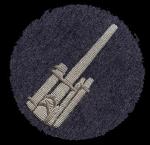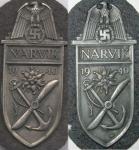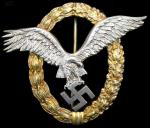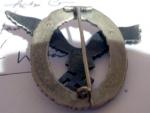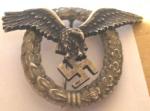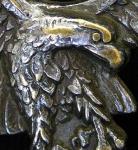-
Posts
3,397 -
Joined
-
Last visited
-
Days Won
3
Content Type
Profiles
Forums
Blogs
Gallery
Events
Store
Everything posted by J Temple-West
-
Ian As far as the ?GWL? maker mark is concerned? marks with and without the defect will be found on original badges. The defect is most likely due to damage after the making of the maker mark stamp as I can?t see a die cutter making such a mistake during the initial cutting. As you say, a maker mark with defect could be faked and probably has been. However, the one characteristic found on the Pilot and Pilot/Observer that the fakers haven?t, as yet, managed to copy is the tooling (aka ?fingerprint?) marks on the reverse of the badges. This Characteristic is for me one of the requirements for originality as well as standard of construction, materials used, hinge/catch/pin assembly and rivets. I?ll post my Pilot, Observer and Pilot/Observer, followed by maker marks of the three. Looking at the three maker marks, Pilot?s badge shows no defect, Observer shows a slight defect and the Pilot/Observer shows a heavy defect. Is this a sign of progressive wear to the stamp, that more than one stamp was produced, or just a difference in the pressure applied? The three maker marks are identical (except for the defect) which leads me to the conclusion that the defect was caused by damage and was progressive. Always go for textbook examples as fakers are getting ever closer to producing the ?perfect fake? We can only go on the characteristics of known originals?any deviation form the norm should be viewed with suspicion. Pilot's Badge
-
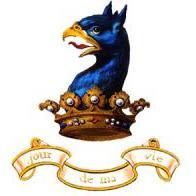
RAD Hewer
J Temple-West replied to lach470's topic in Germany: Third Reich: Uniforms, Headwear, Insignia & Equipment
Rob Wonderful condition, premier maker?what more could you ask for. -
2nd Pattern. Instituted on the 23rd July 1937 (Order: LV 37, No 968) replacing the 1st pattern. Generally considered to be a specialty trade patch, the ?Insignia of the Flak Artillery arm badge? (Flaktaetigskeitabzeichen) should (IMO) be thought of more in terms of a service/achievement award as the criteria for receiving the badge was somewhat different to that of the usual trade patches that were issued, together with the qualification certificate, to individuals who successfully completed courses in a particular field. The ?Insignia of the Flak Artillery badge? was awarded to selected members of flak units who had served for a minimum nine months, and was dependent on probation under combat conditions. Again, unlike the usual trade patch, an award ceremony was prescribed to take place on the 1st August of each year where the badge was proudly presented to entire flak crews (NCO?s & privates) or individuals who had excelled within the unit. The information available points to it being an award rather than a trade qualification badge. If a trade qualification badge, which trade(s) did it cover? Does anyone have the full regulations/criteria pertaining to the badge, as I would love have an answer to this age-old question? Shown below is an example of an early embroidered badge on Luftwaffe uniform material.
-
So, the Narvik Shield?total confusion reigns as to what is and is not original, IMO. The only advice I can give to those who are as confused as I am is to, if given the choice, choose the type shown by Prosper (post # 10) or the type attributed to ?Deumer? (also faked so all the usual checks should be made) which has the metal remaining in the spaces between the eagle?s head and wings. In this way you can be confident of acquiring an original as both types have been found in groups and on period-correct uniform. Everything else should be considered on shield-by-shield bases and all characteristics taken into account. I wait with eager anticipation for the publication of Pascal Huysmans?s reference work on the subject. Then perhaps all will be made clear. Until then, I remain?confused.
-
To make matters even more confusing, I refer you to the picture of the shield taken from a period book and presented by our own Gordon Williamson proving the point that the ?short-tailed 9? (till this point considered a characteristic of a fake) was indeed found on originals. Not a particularly good image?but look at the 4. Is it smaller that the zero? I leave that up to you to decide.
-
I think you?re right, Jos. The detail is just not there. The term ?small 4 fake? has me confused (easily done, before anyone else says it ) I know there is a supposed fake with the characteristic ?small 4? but I don?t think that Vince?s example is one of these as the 4?s on both Joe?s and Vince?s look to be the same size. What I consider to be the classic ?small 4? is as the one shown below.
-
Rather a heated answer there, Vince. Joe has given an honest opinion based on his experience. Perhaps a little less indignation and more of the ?helping hand? approach would be more appropriate? You have given your reasons as to why you think your shield is original? perhaps Joe will be good enough to post some comparisons and give us his reasons for putting this one down as a fake. Both sets of photographs are a little less than ideal, hence my reluctance to comment either way. I will say, however, that ?detail? is not always the best indicator of an original piece. There are some very highly detailed fakes out there. So guys let's get those cameras out and post some clearer pictures.





